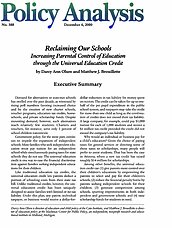Demand for alternatives to state-run schools has swelled over the past decade, as witnessed by rising poll numbers favoring increased choice and by the creation of new charter schools, voucher programs, education tax credits, home-schools, and private scholarship funds. Despite mounting demand, however, such alternatives reach relatively few students. Charters and vouchers, for instance, serve only 2 percent of school children nationwide.
Government policy, for the most part, continues to impede the expansion of independent schools. Most families who seek independent education must pay tuition for an independent school while simultaneously paying taxes for state schools they do not use. The universal education credit is one way to ease the financial discrimination against families seeking independent educations for their children.
Like traditional education tax credits, the universal education credit lets parents deduct a portion of schooling costs from their state tax bill. Unlike traditional credits, however, the universal education credit has been uniquely designed to assist families with limited or no tax liability. Under this plan, any parent, individual taxpayer, or business would receive a dollar-for-dollar reduction in tax liability for money spent on tuition. The credit can be taken for up to one-half of the per pupil expenditure in the public school system, and taxpayers may take the credit for more than one child as long as the combination of credits does not exceed their tax liability. A large company, for example, could pay $1,000 tuition for each of 1,000 students and receive a $1 million tax credit provided the credit did not exceed the company’s tax liability.
Why would an individual or business pay for a child’s education? Given the choice of paying taxes for general services or directing some of those taxes to scholarships, many people will prefer to assist students. That has been the case in Arizona, where a new tax credit has raised roughly $14 million for scholarships.
Among other benefits, the universal education credit can (1) give parents more control over their children’s educations by empowering the parents to select and pay for their children’s schools; (2) reduce the financial penalty borne by parents seeking independent schools for their children; (3) generate competition among schools, spurring improvements in both independent and government schools; and (4) raise scholarship funds for students in need.
About the Authors

This work is licensed under a Creative Commons Attribution-NonCommercial-ShareAlike 4.0 International License.
